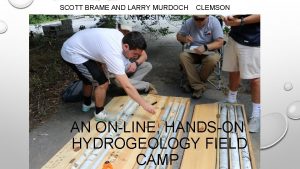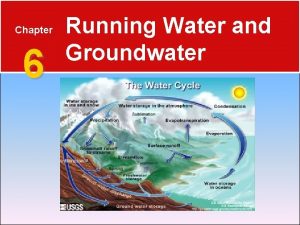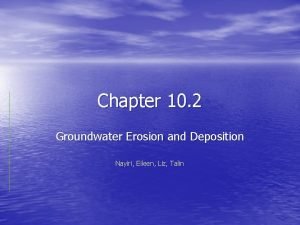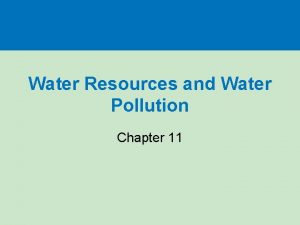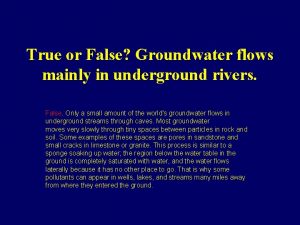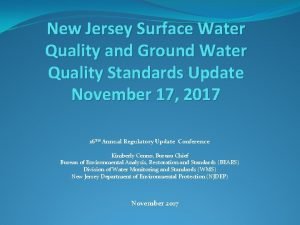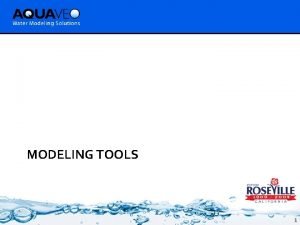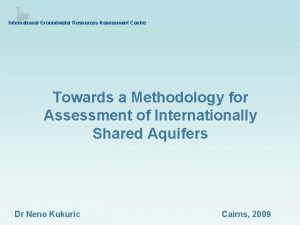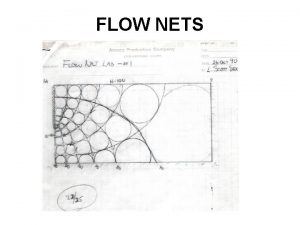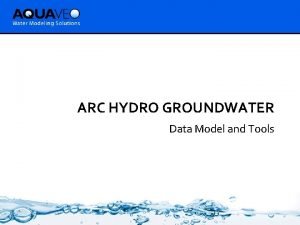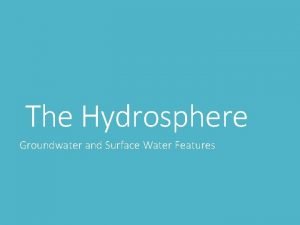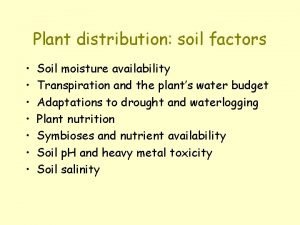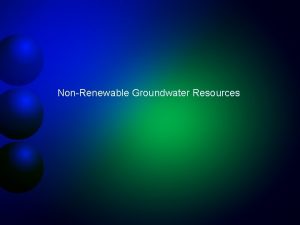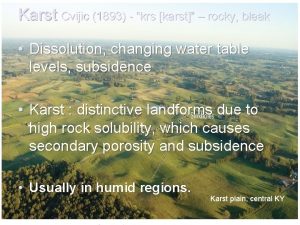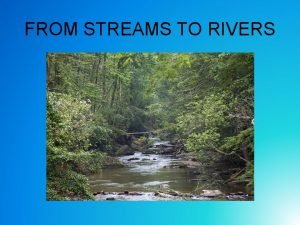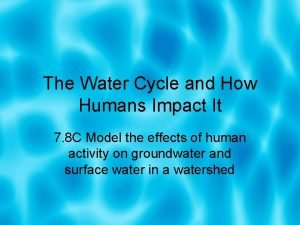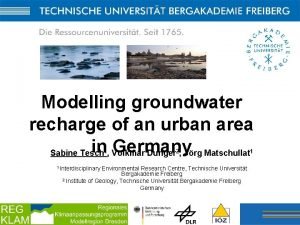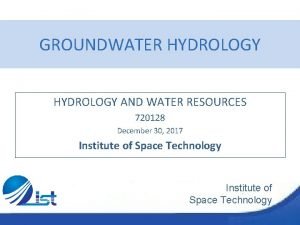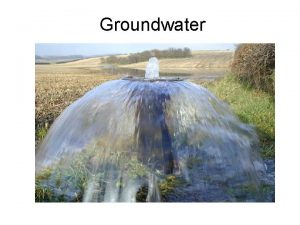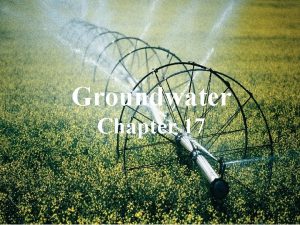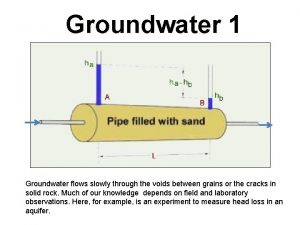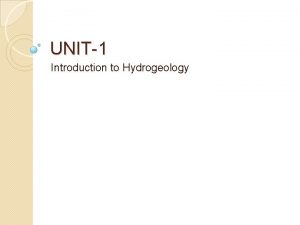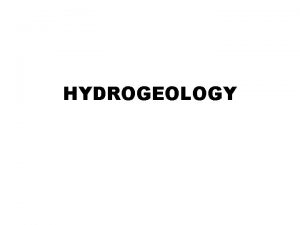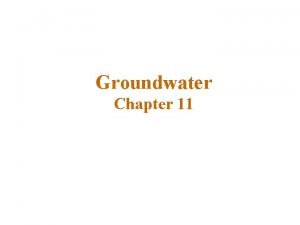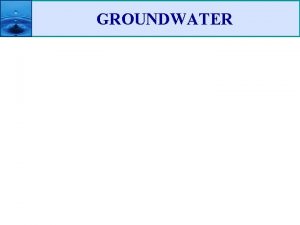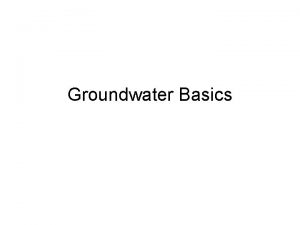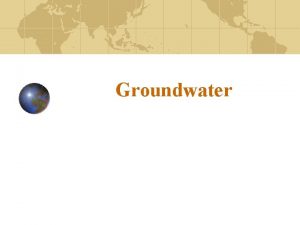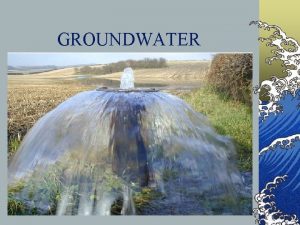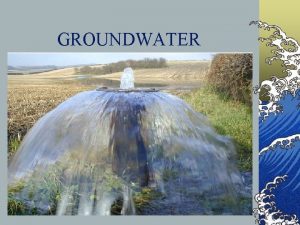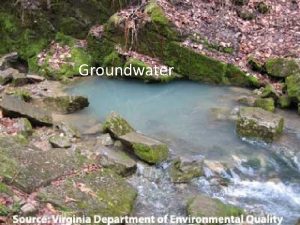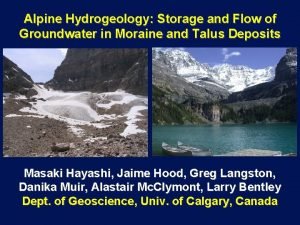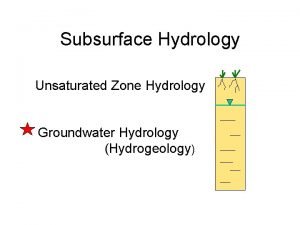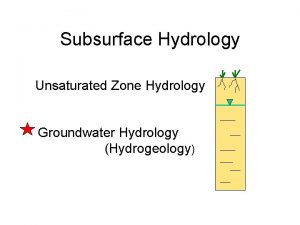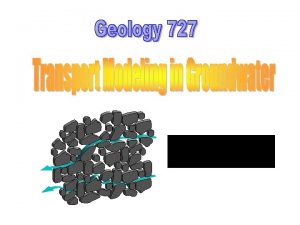Florida Groundwater and Hydrogeology Groundwater provides 98 of
































- Slides: 32

Florida Groundwater and Hydrogeology

Groundwater provides 98% of all available freshwater Total Water Withdrawals 21% United States Surface Water 62% Florida Groundwater More than 90% of Florida’s drinking water is from groundwater

Florida’s Groundwater

The Florida Platform -300 ft The edge is defined as where the water depth is at 300 feet. 100 miles west of Tampa 3 -5 miles east of Miami 30 -40 miles east of St. Augustine

Origins of the Florida Platform Precambian 4. 6 Bya to 570 Mya (Earth formation, cooling, oceans, atmosphere, life, oxygen) Paleozoic 570 Mya to 248 Mya Mesozoic 248 Mya to 65 Mya Cenozoic 65 Mya to present

Approximately 250 million years ago

Breakup of Pangaea Late Triassic, early Jurassic ~200 Mya - 250 Mya Rifting phase: Creation of the Atlantic Ocean

Approximately 150 million years ago Stable, shallow sea floor Subject to marine sedimentation Sedimentation: settling of particles from a fluid due to gravity For the next several million years the area was dominated by carbonate sedimentation Late Jurassic

Dissolving Salt in Water Na. Cl KCl solubility In water = 280 g/L Ca. SO 4 solubility In water = 2. 4 g/L Na+ Cl- Na+ Ions: stable forms of the elements that obtain charge by gaining or losing electrons. Na. Cl solubility In water = 350 g/L

Precipitation and Sedimentation The opposite of dissolution is precipitation Ions in solution come together to make a solid + charge ion Solid - charge ion

Ocean Salts Chloride Cl- Sodium Na+ Potassium Carbonate CO 3 -2 K+ Calcium Ca+2 Magnesium Mg 2+ Sulfate SO 4 -2

Precipitation and Carbonate Platforms Chloride Sodium Cl- Na+ Carbonate CO 3 -2 Calcium Ca+2 solid Ca 2+ + CO 32 - = Ca. CO 3 Sulfate -2 Calcium and carbonate are at SO near saturation levels in oceans 4 (amounts are close to a threshold for precipitation)

Carbonate Deposition/Sedimentation Marine Calcium and Magnesium Carbonate Ca. CO 3 Mg. CO 3 Foraminifera Mollusks Algae Corals

Calcification requires: Warm, shallow water, sunlight

zooxantellae Symbiosis Photosynthetic: Consumes CO 2 Coral polyp Hermatypic Corals Symbiosis promotes Calcium precipitation Precipitated Ca. CO 3

Between about 150 Mya and 25 Mya Florida platform was a flooded, submarine Ca. CO plateau dominated by carbonate deposition 3 Sea level Changes Present Sea level FL platform 150 Time: millions of years ago 25


The Eocene and Oligocene Limestone The Eocene and Oligocene limestone forms the principal fresh water-bearing unit of the Floridan Aquifer, one of the most productive aquifer systems in the world Eocene: 55 – 34 million years ago Oligocene: 34 – 24 million years ago

Extensive Carbonate Platform Millions of years, miles thick *

Continental Influences

Sedimentation on the Florida Peninsula Sediments

Isolation of the Florida Platform Sandy, Clayey Sediments Georgia Channel Suwannee Current

Isolation of the peninsula from continental influences allowed carbonates to build on the platform for 125 million years Fundamental change came approximately 25 million years ago

Events of the Late Oligocene Epoch, approximately 25 Mya Raising of the Florida Platform Lowering of Sea Levels, Interruption of Suwannee Current +100 ft

Rejuvenation of Appalachians, increased sediment load sediments Miocene Epoch: beginning approximately 24 Mya

These Sediments were Silicon-based Sands, Silts, Clays, Rocks, and Rock Fragments KAl. Si 3 O 8 Ca. Al 2 Si 2 O 8 Na. Al. Si 3 O 8 Mg. Si. O 4 Feldspars Olivine Muscovite KAl 3 Si 3 O 10 They are typically called “siliciclastics”

Filling in the Georgia Channel Sandy, Clayey Sediments Georgia Channel Suwannee Current

Sediments Rising sea levels allow sediments to become suspended in water and drift over the platform

Sandy, Clayey Sediments These sediments confine the water in the limestone Commonly referred to as the Hawthorne Formation

Summary 1. 2. 3. 4. Deposition of Eocene/Oligocene Limestone (55 – 24 Mya) Raising of the Florida platform Lowering of sea levels, interruption of the Suwannee Current Infilling of the Georgia Channel with sediments derived from Appalachian/continental erosion 5. Sea level rise, lack of Suwannee current. 6. Suspended siliciclastic sediments settle over the peninsula 7. These sediments blanket the underlying limestone forming the upper confining layer for the Floridan Aquifer.

Basic Florida Geology Sands sands, silts, clays, rock Limestone Confining unit Water-bearing unit Miocene deposits are siliciclastic: sands, silts, clays, rocks These deposits are known commonly as the Hawthorne Formation. They overlie the Eocene and Oligocene limestone deposits and form the upper confining unit for the Floridan Aquifer.

 Clemson hydrogeology field camp
Clemson hydrogeology field camp Running water and groundwater
Running water and groundwater Chapter 6 running water and groundwater
Chapter 6 running water and groundwater Groundwater erosion and deposition
Groundwater erosion and deposition Source of contamination
Source of contamination We can reduce water pollution
We can reduce water pollution True or false: groundwater can flow.
True or false: groundwater can flow. Njdep groundwater quality standards
Njdep groundwater quality standards Gms groundwater modeling
Gms groundwater modeling Groundwater assessment methodology
Groundwater assessment methodology Water table
Water table Septic tank contamination groundwater
Septic tank contamination groundwater Groundwater flow net
Groundwater flow net The term geologists use for underground water is
The term geologists use for underground water is Brainpop.com water cycle
Brainpop.com water cycle Rajiv gandhi groundwater raipur
Rajiv gandhi groundwater raipur Total hydraulic head
Total hydraulic head Groundwater porosity
Groundwater porosity Arc hydro groundwater
Arc hydro groundwater Surface water features
Surface water features Lenticels
Lenticels Is groundwater renewable or nonrenewable
Is groundwater renewable or nonrenewable Caves and karst topography webquest answer key
Caves and karst topography webquest answer key How does groundwater rejoin the water cycle
How does groundwater rejoin the water cycle Human impact on groundwater
Human impact on groundwater Groundwater
Groundwater Infiltration definition geography
Infiltration definition geography Groundwater system
Groundwater system Iöz
Iöz بئر ارتوازي
بئر ارتوازي Uses of groundwater
Uses of groundwater Cone of depression water table
Cone of depression water table Darcy law
Darcy law
